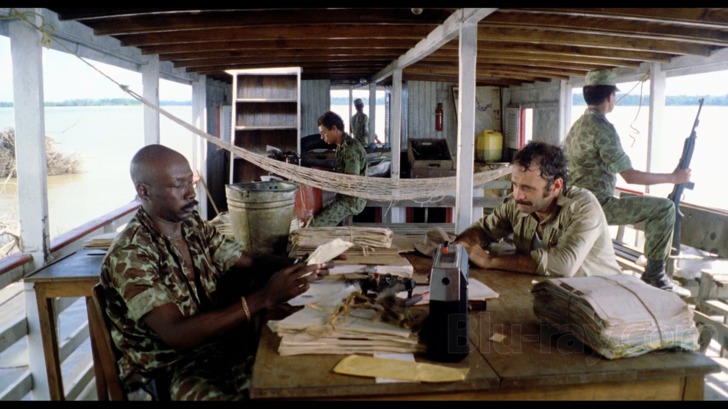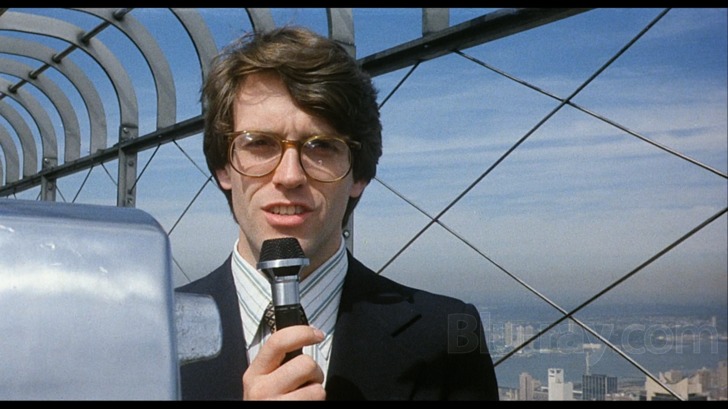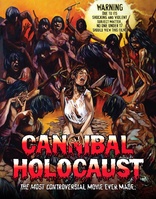Cannibal Holocaust Blu-ray Movie
HomeCannibal Holocaust Blu-ray Movie 
Blu-ray + CDGrindhouse Releasing | 1980 | 1 Movie, 2 Cuts | 96 min | Unrated | Jul 01, 2014
Movie rating
6.8 | / 10 |
Blu-ray rating
| Users | 5.0 | |
| Reviewer | 4.5 | |
| Overall | 4.5 |
Overview
Cannibal Holocaust (1980)
A New York anthropologist named Professor Harold Monroe travels to the wild, inhospitable jungles of South America to find out what happened to a documentary film crew that disappeared two months before while filming a documentary about primitive cannibal tribes deep in the rain forest. With the help of two local guides, Professor Monroe encounters two tribes, the Yacumo and the Yanomamo. While under the hospitality of the latter tribe, he finds the remains of the crew and several reels of their undeveloped film. Upon returning to New York City, Professor Monroe views the film in detail, featuring the director Alan Yates, his girlfriend Faye Daniels, and cameramen Jack Anders and Mark Tomaso. After a few days of traveling, the film details how the crew staged all the footage for their documentary by terrorizing and torturing the natives.
Starring: Robert Kerman, Francesca Ciardi, Perry Pirkanen, Luca Barbareschi, Paolo PaoloniDirector: Ruggero Deodato
| Horror | Uncertain |
| Drama | Uncertain |
| Adventure | Uncertain |
Specifications
Video
Video codec: MPEG-4 AVC
Video resolution: 1080p
Aspect ratio: 1.85:1
Original aspect ratio: 1.85:1
Audio
English: DTS-HD Master Audio 2.0 (48kHz, 24-bit)
English: DTS-HD Master Audio Mono (48kHz, 24-bit)
Subtitles
None
Discs
50GB Blu-ray Disc
Three-disc set (2 BDs, 1 CD)
Playback
Region free
Review
Rating summary
| Movie | 4.0 | |
| Video | 4.0 | |
| Audio | 4.5 | |
| Extras | 5.0 | |
| Overall | 4.5 |
Cannibal Holocaust Blu-ray Movie Review
(I Wish I Never) Found Footage.
Reviewed by Brian Orndorf July 4, 2014One must tread carefully when discussing “Cannibal Holocaust.” The notorious 1980 horror effort from director Ruggero Deodato has acquired quite a reputation throughout the years, subjected to censorship, legal proceedings, and derision, all the while amassing a cult following over the last three decades, nurtured by fans who choose to see the picture as a statement on humanity, refusing to indulge the feature’s initial condemnation. It’s brutal, senseless, and excessive -- hardly a Saturday night Redbox rental to be viewed after a nice dinner and a bottle of wine. It’s specific cinema for a knowledgeable audience, and indeed, underneath all the violence and grim happenings, there’s fascinating work and thematic investigation to discover. “Cannibal Holocaust” is rough, but it’s an interesting type of sensationalism from a (thankfully) bygone production era. It’s not a film to be enjoyed, but it certainly offers a singular genre bite that’s impressively gonzo.

Traveling to the Amazon rainforest to figure out what happened to a group of documentarians out in the jungle to film indigenous tribes, Professor Harold Monroe (Robert Kerman) teams with tracker Cacho (Salvatore Basile), marching into dangerous jungle terrain known as “The Green Inferno.” Coming across two warring tribes, the Yanomamo and the Shamatari, Monroe is able to win the trust of the natives, eventually retrieving footage from the original expedition, left behind with the rotting remains of filmmakers Alan (Carl Yorke), Faye (Francesca Ciardi), Jack (Perry Pirkanen), and Mark (Luca Barbareschi). Returning to New York City to prepare a documentary about the deceased and their history of front-line reporting, Harold studies the recovered footage, horrified to see how Alan and his crew truly behaved in the Amazon, lashing out at the natives on a power trip intended to manufacture marketable images of violence and enhance their journalistic reputation.
“Cannibal Holocaust” is actually two films for the price of one. The opening half is devoted to Monroe’s journey into the Amazon, where the anthropologist puts his safety into Cacho’s hands and works his way into the middle of the jungle, encountering the feral nature of primitive cultures. Monroe finds oppressive heat, rivers filled with leeches, and stumbles on a ritualistic murder of a young adulteress, who’s repeatedly penetrated with a stone phallus, violated with mud, and beaten to death, giving the American a potent look at the nature of the land’s inhabitants. Of course, this is also where Deodato establishes the tone of “Cannibal Holocaust,” mixing horror with exploitation in a manner that’s unnerving but admittedly suspenseful, exposing the viewer to a level of shock value that he seems determined to top.
Perhaps the most famous element of “Cannibal Holocaust” is the actual killing of jungle creatures, with Deodato’s camera concentrating on the slaughter and dismemberment of a large turtle, spider, squirrel monkey, pig, coatimundi, and a snake. It’s an undeniably ugly and a completely unnecessary addition to the movie, and while local dietary customs aren’t being disputed here, the need for Deodato to commit such suffering to film is. There are enough powerful special effects on display (including the iconic image of a young tribal girl impaled on a standing pole) to suggest fakery could’ve been pulled off. Instead, the production lingers on slippery entrails, screaming, and limb-twitching, making an already difficult feature downright loathsome at times. Humans don’t exactly fare much better in “Cannibal Holocaust,” but at least the actors were able to get up and walk away when the cameras stopped rolling. One doesn’t have to be a PETA maniac to feel the intense anxiety that arrives with this level of cruelty.
The other half of “Cannibal Holocaust” concerns Monroe’s review of the lost footage, which details how Alan and his crew stomped into a tribal hot zone acting as gods, terrorizing the locals through violence and intimidation. It’s megalomaniacal viciousness with something of a point, revealing Alan’s insatiable hunger to stage horrors as a way of creating his own documentary reality, which does mirror modern culture’s current fascination with trainwreck television and merciless viral video trauma. Instead of confidently nailing his message of true barbarism, Deodato stumbles awkwardly over such salesmanship, but salient points are made on concept of media manipulation and uneducated cultural condemnation, buttoned with a corny “who are the real cannibals?” parting shot. Perhaps the academic value of “Cannibal Holocaust” is a bit clouded, but that there’s anything here worth pondering once the end credits roll is a miracle. The effort is appreciated.
There isn’t much levity to “Cannibal Holocaust,” which provides only one mildly amusing scene featuring Monroe bathing nude in the Amazon while being accosted by native girls. Otherwise, the mood of the effort is oppressive, but often invitingly so, thanks to a spectacular score from Riz Ortolani, who somehow finds a somber orchestral beauty to give the picture a cinematic presence. The composer also indulges terror beats with electro stings, but the majority of Ortolani’s work carries real beauty, helping to disguise the truly macabre extremes Deodato reaches for. Cinematography also retains artistry, creating a believable “found footage” look for the second half, selling the film-with-the-film almost seamlessly, save for some exaggerated acting.
For the understandably uneasy out there, Grindhouse has included a “Cruelty-Free Version” of the film, skipping all the animal slaughter sections.
Cannibal Holocaust Blu-ray Movie, Video Quality 

The AVC encoded image (1.85:1 aspect ratio) presentation brings "Cannibal Holocaust" to BD in a big way. While points of damage and speckling are detected, the image is surprisingly clean for such an intentionally mangled movie. Fine detail is satisfactory, bringing out the sweatbox environment with pronounced perspiration and horrified facial responses, and gore zone visits are ideally textured, allowing the viewer to study that frightening line between fact and fiction as guts are paraded around for inspection. Colors are reasonably strong, without intense fade, displaying greenery, accurate skintones, and more varied hues during bloodletting sequences. Grain is managed well, preserving a filmic look while smoothly supporting changes in cinematography, maintaining the difference between 35mm and the 16mm documentary footage.
Cannibal Holocaust Blu-ray Movie, Audio Quality 

The 2.0 DTS-HD MA sound mix is billed as a "digital stereo re-mix" and proves its worth immediately, offering impressive instrumentation on Ortolani's main theme, with crisp acoustic guitar strumming and warped electronic accompaniment. Although the elements are limited in scope, boosting helps bring out the sonic flavors of the track, moving away from a slightly sludgier mono mix (also included here). Dialogue is crisp and contained, managing emotional extremes well. Scoring is alert but never overwhelming, and while it's often used for shock value, volume riding isn't necessary to tame it. Sound effects are inherently sharp, hitting a shrill upper range that's perhaps unavoidable, with gunshots most piercing. Distortion isn't an issue.
Cannibal Holocaust Blu-ray Movie, Special Features and Extras 

- Booklet presents 23 pages (and a grisly centerfold!) of essays from Eli Roth (his "Cannibal Holocaust" tribute, "The Green Inferno," opens in September), Chas. Balun, Gergely Hubai, and Martin Beine.
- CD soundtrack of Riz Ortolani's score (10 tracks total) is offered in a cardboard sleeve.
- Commentary #1 features director Ruggero Deodato and actor Robert Kerman.
- Commentary #2 features stars Carl Yorke and Francesca Ciardi.
- "The Last Road to Hell" (1:46, SD) is an extended cut of the doomed documentarians' previous work, shown to Monroe inside an editing room. Containing even more graphic atrocities, it makes the very real footage all the more difficult to buy as fakery from the filmmaking ghouls. Less is more when it comes to this brief section of the picture.
- An International Trailer (3:06, HD), Italian Trailer (3:09, HD), German Trailer (2:12, SD), U.S. Original Trailer (1:25, HD), and a U.S. Re-Release Trailer (1:59, HD) are included.
- Ruggero Deodato Interview (58:08, HD) is dated 4/1/11 and encompasses the production background of his "Rainforest Terror" trilogy, comprising "Last Cannibal World," "Cannibal Holocaust," and "Cut and Run." Labeling himself a "pioneer," the helmer is quick to explain how the animal cruelty came about, swearing it wasn't his idea, with the violence added to help sell the feature to the Asian market. Deodato also emphasizes how anything killed in "Cannibal Holocaust" was eaten. A discussion of location difficulties, financing, and his eventual court battle over the realism in "Cannibal Holocaust" is included.
- Robert Kerman Interview (35:37, SD) is dated 11/13/00 and finds the lead actor in a candid mood, exploring his strange relationship with "Cannibal Holocaust," a movie he openly despises (the animal killing positively guts him). His passion is something to see, but he's also prone to rambling, not as sharply focused as hoped for.
- Carl Yorke Interview (56:18, SD) is dated 5/16/05 and is a remarkably vivid trip down memory lane with the actor, who offers rich, detailed anecdotes concerning the making of the movie. Eventually believing he was acting in a snuff film, Yorke shares his disgust with the animal killing (refusing to take part) and location challenges, also chatting about his difficult relationships with co-stars and Deodato. He's open, honest, and ready to share, helping the viewer understand the how the picture came to be.
- Francesca Ciardi Interview (38:21, HD) is dated 4/29/10 and adds yet another thespian perspective, with the Italian actress recalling the struggles of working in the Amazon, her relationship with co-stars, and her revulsion with the animal killings. Ciardi also reveals a few special effects tricks used during the shoot. Her broken English is a little difficult to decode, but her contribution is valued.
- Salvatore Basile Interview (30:32, HD) is dated 1/8/14 and highlights the actor lounging inside his home in Columbia. A veteran of movie productions, Basile works through his filmography and clarifies the cinematic intent of "Cannibal Holocaust," emerging as perhaps the only person involved with the picture to downplay the shock of the animal slaughter sequences, chalking them up to circle of life circumstances.
- Riz Ortolani Interview (5:00, SD) is dated 4/15/03 and explores tonal motivations for the film's unique score.
- Robert Forges Davanzati Interview (12:31, HD) is dated 4/28/10 and finds the camera operator in Dario Argento's Profondo Rosso store, surrounded by horror memorabilia. While he discusses a few technical details, Davanzati is more interested in the picture's reception and legal woes, openly wondering what's actually being achieved when the government bans a movie.
- Cinema Wasteland Panel (28:22, HD) is dated 4/1/11 and features Deodato sharing anecdotes about his career experiences in front of an enthusiastic crowd.
- Francesca Ciardi Q&A (11:14, HD) is dated 10/13/10 and showcases the actress discussing her craft and onset experiences.
- Carl Yorke and Ruggero Deodato Reunion (10:25, SD) is dated 4/18/09 and highlights a strange interaction between the actor and director at a Fangoria convention, with Yorke explaining that he hasn't seen Deodato since he left the Columbian set in 1979. It's a casual encounter, a little hard to understand due to Deodato's excited English, but it seems friendly enough.
- Robert Kerman and Ruggero Deodato Reunion (8:48, SD) is dated 11/11/00, presenting a convention panel where the actor and director share memories from the set. Afterwards, Kerman stays to sign autographs and chat with the fans.
- Still Galleries are broken up into Production Stills (97 images), Behind the Scenes (34 images), Promotional Materials from Italy, Germany, Spain, Japan, and Various (108 images), Video Releases (65 images), and Mondo Cannibal (70 images).
Cannibal Holocaust Blu-ray Movie, Overall Score and Recommendation 

How could a movie filled with rape, murder, and mutilation be recommended? "Cannibal Holocaust" is chilling and gruesome, but it's not completely without value, especially to cinephiles able to appreciate the sensation of realism Deodato is striving to preserve. While he works in horror tropes, the helmer generates an acrid air of exploration, requiring a sophisticated viewer skilled at separating lip-licking provocation and real screen craftsmanship. "Cannibal Holocaust" isn't for everybody, reserved strictly for those willing to visit a dark place, observing an unbridled era of filmmaking from a safe distance.
Similar titles
Similar titles you might also like

Cannibal Ferox
1981

Doctor Butcher M.D. / Zombie Holocaust
1980

The Green Inferno
Collector's Edition
2013

Zombie 4K
Zombi 2 / Zombie Flesh Eaters
1979

Eaten Alive! 4K
Mangiati vivi! Standard Edition
1980

I Spit on Your Grave 4K
Day of the Woman
1978

Sacrifice!
Il paese del sesso selvaggio / Man From Deep River / Deep River Savages
1972

Cat in the Brain
Un gatto nel cervello | Glow in the Dark Cover & Mini Portrait of Lucio Fulci Limited Edition to 3000
1990

The Beyond 4K
...E tu vivrai nel terrore! L'aldilà / Seven Doors of Death | Standard Edition
1981

Last Cannibal World
Jungle Holocaust | Ultimo mondo cannibale | Carnivorous | Cannibal | The Last Survivor | Standard Edition
1977

Slave of the Cannibal God 4K
The Mountain of the Cannibal God | La montagna del dio cannibale | Prisoner of the Cannibal God | Standard Edition
1978

Bite
2015

Condemned
2015

Beyond the Darkness
Buio Omega
1979

I Drink Your Blood
Also Includes = I Eat Your Skin and Blue Sextet
1970

King Kong
Warner Archive Collection
1933

Emanuelle and the Last Cannibals
Emanuelle e gli ultimi cannibali
1977

Massacre in Dinosaur Valley
Nudo e selvaggio | Standard Edition
1985

Anthropophagous
1980

Primitives
Primitif | Savage Terror | Standard Edition
1978


